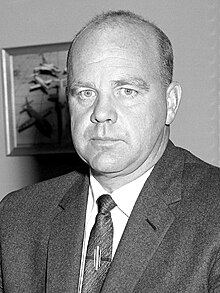Paul Bikle
| Paul F. Bikle | |
|---|---|

Director Paul F. Bikle, at NASA's Flight Research Center (FRC) in 1959 (from NASA Photo E-4875)
|
|
| Born |
5 June 1916 Wilkinsburg, Pennsylvania, U.S. |
| Died | 19 January 1991 (aged 74) Salinas, California, U.S. |
| Nationality | United States |
| Education | University of Detroit, B.S. 1939 |
| Aviation career | |
| Known for | Inspiring the Rogallo wing used in many modern hang-gliders |
| Famous flights | He established two world soaring records on 25 February 1961 while flying his Schweizer SGS 1-23E near Lancaster, California, achieving an altitude of 46,267 ft (14,102 m) feet and a total-altitude-gained mark of 42,300 ft (12,900 m). |
Paul F. Bikle (5 June 1916 Wilkinsburg, Pennsylvania – 19 January 1991 Salinas, California) Director of the U.S. National Aeronautics and Space Administration (NASA) Dryden Flight Research Facility from 1959 until 1971, and author of more than 40 technical publications, has been associated with major aeronautical research programs including the supersonic X-15 rocket plane, and also was a world record setting glider pilot.
Before graduating from the University of Detroit in 1939 with a BSc. degree in aeronautical engineering, Bikle's activity in the student chapter of the Institute of the Aeronautical Sciences (IAS), and the school gliding and flying clubs, led to flight instruction and a pilot's license from the C.A.A., the predecessor to the FAA. He later became a fellow in the American Institute of Aeronautics and Astronautics, the successor to the IAS. Mr. Bilke worked for Taylorcraft Aircraft in Ohio before beginning his government service career.
His career with the U.S. Air Force began in 1940 when he was appointed an aeronautical engineer at Wright Field. In 1944 he was named Chief of the Aerodynamics Branch in the Flight Test Division there. While working closely with other government agencies in establishing the first flying qualities specifications for aircraft, he also wrote AAF Technical Report 50693 Flight Test Methods, which was used as a standard manual for conducting flight tests for more than five years. During the World War II years he was involved in more than 30 test projects and flew over 1,200 hours as an engineering observer.
...
Wikipedia
